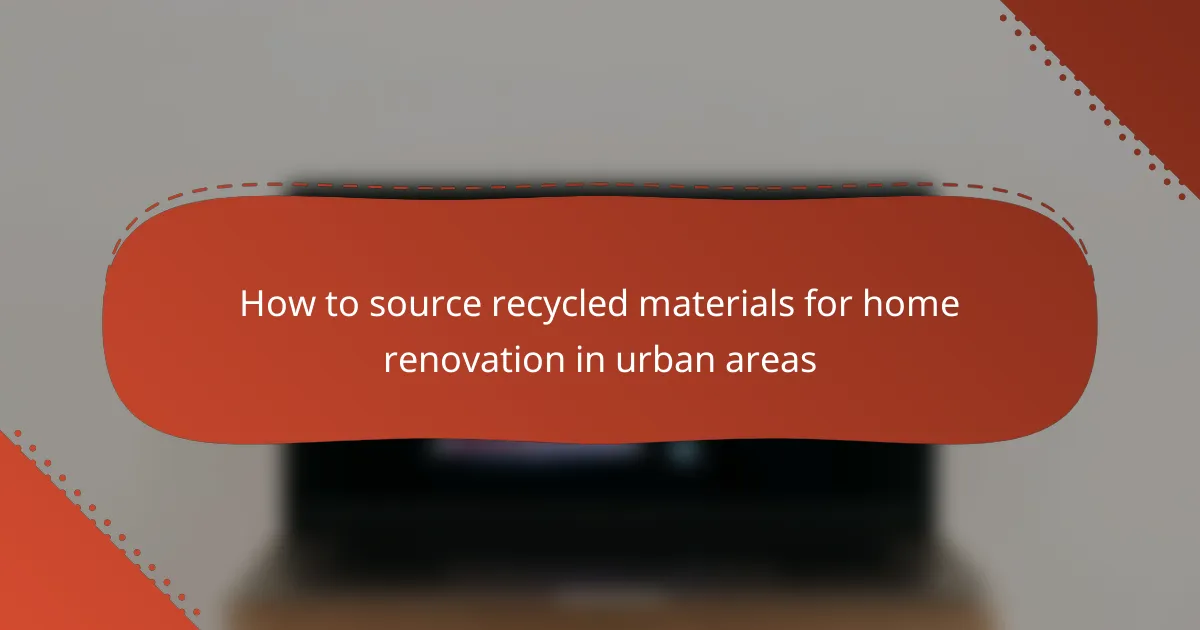Sourcing recycled materials for home renovation is an eco-friendly approach that can enhance your project while saving money. By utilizing local resources for salvaged items like reclaimed wood and recycled metal, you can reduce waste and create distinctive design elements that add character to your home. Embracing these materials not only benefits the environment but also allows for a more personalized renovation experience.

How to source recycled materials for home renovation in urban areas
Sourcing recycled materials for home renovation in urban areas involves finding local resources that offer salvaged items. This approach not only reduces waste but can also save money and add character to your project.
Local salvage yards
Local salvage yards are excellent places to find a variety of recycled materials, including doors, windows, and fixtures. These yards often have a rotating inventory, so visiting frequently can yield new finds. Prices are typically lower than retail, making it a budget-friendly option.
When visiting a salvage yard, inspect items carefully for damage and ensure they meet your renovation needs. It’s also wise to bring measurements to ensure a good fit for your project.
Online marketplaces like Craigslist
Online marketplaces, such as Craigslist, are valuable for sourcing recycled materials from local sellers. You can often find everything from furniture to building supplies at competitive prices. Be sure to check listings regularly, as items can sell quickly.
When purchasing through online platforms, communicate clearly with sellers and arrange safe pickup times. Always verify the condition of items before finalizing the transaction to avoid surprises.
Reclaimed wood suppliers
Reclaimed wood suppliers specialize in salvaging wood from old buildings, barns, and other structures. This wood can be used for flooring, cabinetry, and furniture, providing a unique aesthetic. Prices can vary significantly based on the type and quality of wood.
Look for suppliers that provide information on the wood’s history and treatment. This transparency can help you make informed decisions about sustainability and suitability for your renovation.
Architectural salvage stores
Architectural salvage stores offer a curated selection of reclaimed materials, including vintage fixtures, tiles, and architectural elements. These stores often have knowledgeable staff who can assist you in finding specific items for your renovation project.
While prices may be higher than at salvage yards, the quality and uniqueness of items can justify the cost. Consider visiting these stores during sales or events for potential discounts on your purchases.

What are the benefits of using recycled materials?
Using recycled materials in home renovation offers numerous advantages, including cost efficiency, reduced environmental impact, and distinctive design elements. These benefits make recycled materials an attractive choice for homeowners looking to enhance their spaces sustainably.
Cost savings
One of the primary benefits of using recycled materials is the potential for significant cost savings. Reclaimed wood, recycled metal, and salvaged fixtures often come at a lower price than new materials, allowing homeowners to stretch their renovation budgets further.
Additionally, many local governments and organizations offer incentives or tax credits for using sustainable materials, which can further reduce overall project costs. It’s advisable to research local programs that may provide financial benefits for sourcing recycled materials.
Environmental impact
Utilizing recycled materials greatly reduces the demand for new resources, thereby minimizing environmental degradation. By choosing reclaimed items, homeowners contribute to waste reduction and help conserve energy that would otherwise be used in the production of new materials.
Moreover, using recycled materials can lower greenhouse gas emissions associated with manufacturing and transporting new products. This practice supports a circular economy, where materials are reused and repurposed, benefiting the planet as a whole.
Unique aesthetics
Recycled materials often bring a unique character and charm to home renovations that new materials cannot replicate. For instance, reclaimed wood beams or vintage tiles can add historical significance and a sense of warmth to a space.
Homeowners can also create one-of-a-kind designs by mixing various recycled materials, resulting in personalized aesthetics that reflect individual style. This approach not only enhances the visual appeal but also tells a story through the materials used in the renovation.

What types of recycled materials are available?
Various recycled materials can be sourced for home renovation, including reclaimed wood, recycled metal, salvaged bricks, and recycled glass. These materials not only reduce waste but also add unique character to your projects.
Reclaimed wood
Reclaimed wood is salvaged from old buildings, barns, and other structures, making it a sustainable choice for flooring, furniture, and decorative elements. When sourcing reclaimed wood, check for signs of damage or pest infestation, and ensure it has been properly treated for safety.
Consider the wood’s origin and history, as this can add aesthetic value. Prices for reclaimed wood can vary widely, typically ranging from $3 to $10 per board foot, depending on the type and condition.
Recycled metal
Recycled metal, such as aluminum and steel, is commonly used for roofing, siding, and structural components. Sourcing recycled metal helps reduce the demand for new materials and lowers environmental impact.
When purchasing recycled metal, look for certifications that indicate it meets industry standards. Prices can fluctuate based on market demand, but expect costs to be lower than new metal options.
Salvaged bricks
Salvaged bricks are bricks that have been reclaimed from old buildings and can be reused for walls, patios, or landscaping. They often have a unique patina and character that new bricks lack.
When selecting salvaged bricks, inspect them for cracks or damage. Prices typically range from $0.50 to $2 per brick, depending on their condition and historical significance.
Recycled glass
Recycled glass can be used in various applications, including countertops, tiles, and decorative features. It is often available in a range of colors and finishes, providing versatility in design.
When considering recycled glass, look for products that are certified as post-consumer recycled. Prices can vary, generally falling between $30 to $100 per square foot for countertops, depending on the complexity of the design and the source of the glass.

How to evaluate the quality of recycled materials?
Evaluating the quality of recycled materials involves assessing their condition, certifications, and suitability for your renovation project. High-quality recycled materials can be durable and environmentally friendly, but they require careful inspection to ensure they meet your needs.
Inspect for damage
Begin by thoroughly inspecting recycled materials for any signs of damage, such as cracks, warping, or rust. Look for structural integrity, especially in items like reclaimed wood or metal fixtures, as these defects can compromise safety and performance.
Consider the extent of any damage. Minor cosmetic issues might be acceptable, but significant structural flaws could lead to costly repairs later. If possible, request samples to evaluate their condition before making a purchase.
Check for certifications
Certifications can provide assurance about the quality and safety of recycled materials. Look for labels that indicate compliance with industry standards, such as the Forest Stewardship Council (FSC) for wood products or LEED (Leadership in Energy and Environmental Design) certifications for various materials.
Research the specific certifications relevant to your project. For instance, materials with verified recycled content can contribute to sustainability goals. Always ask suppliers for documentation to confirm these certifications before finalizing your purchase.

Where to find local recycled material suppliers?
Local recycled material suppliers can be found through various channels, including community reuse centers, salvage yards, and online marketplaces. These resources provide a range of materials that can be used for home renovation projects, often at lower costs than new materials.
Community reuse centers
Community reuse centers are dedicated facilities that accept and sell donated building materials, furniture, and other household items. They often focus on sustainability and reducing waste, making them a great option for sourcing recycled materials.
When visiting a community reuse center, check their inventory regularly, as stock can change frequently. You may find everything from reclaimed wood and bricks to appliances and fixtures, often at a fraction of retail prices.
Before purchasing, ensure that the materials meet your project requirements. Inspect items for damage and verify any local building codes that may apply to reused materials.
